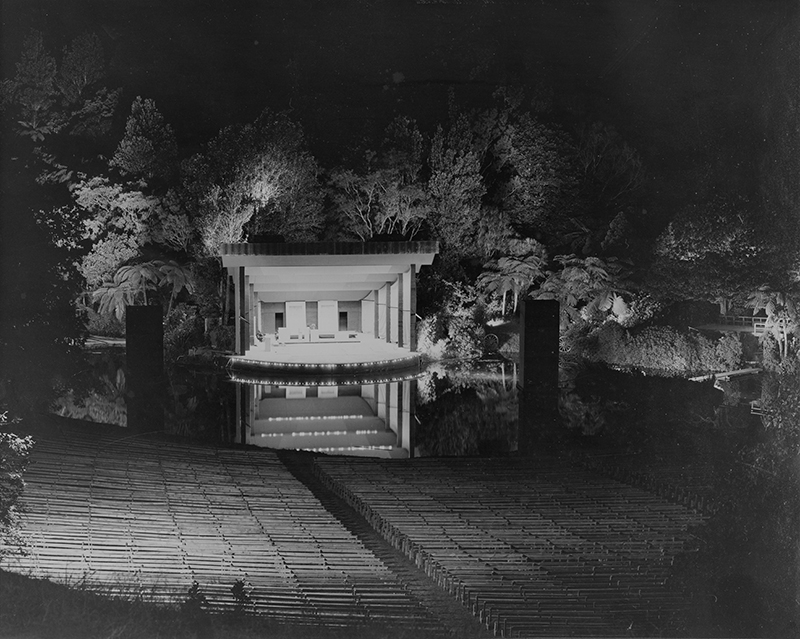
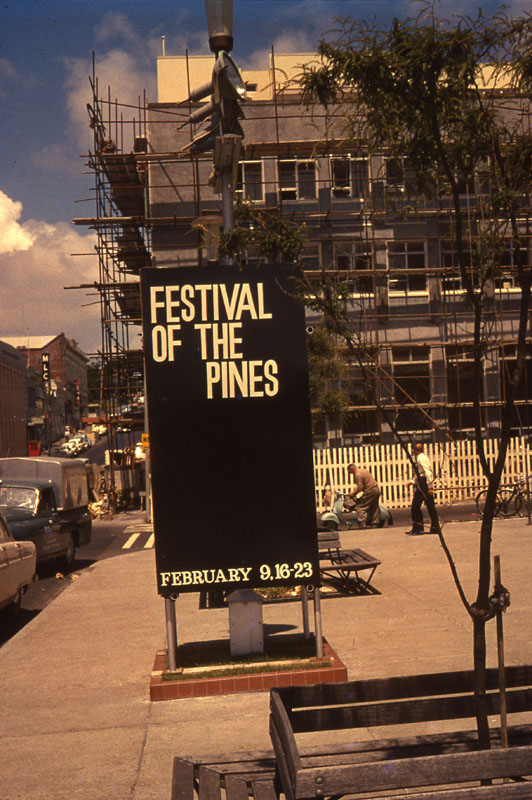
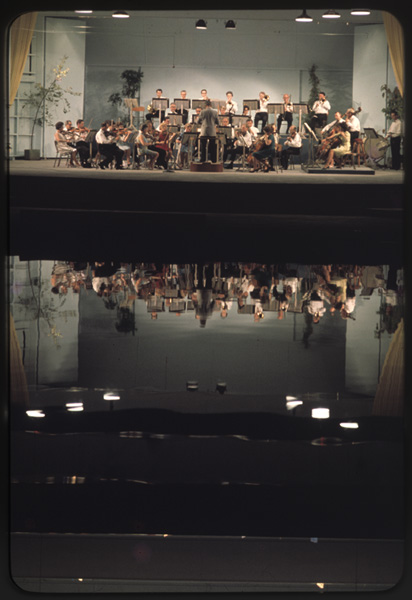
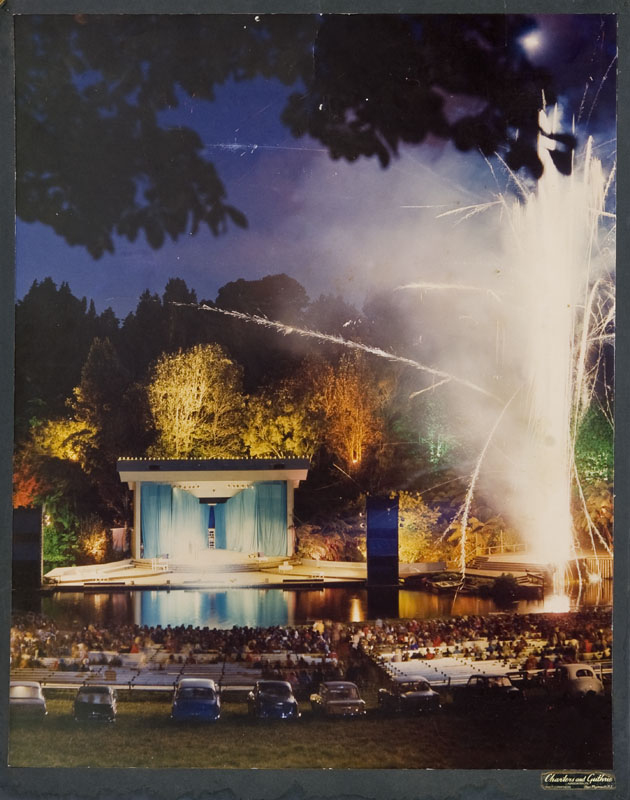
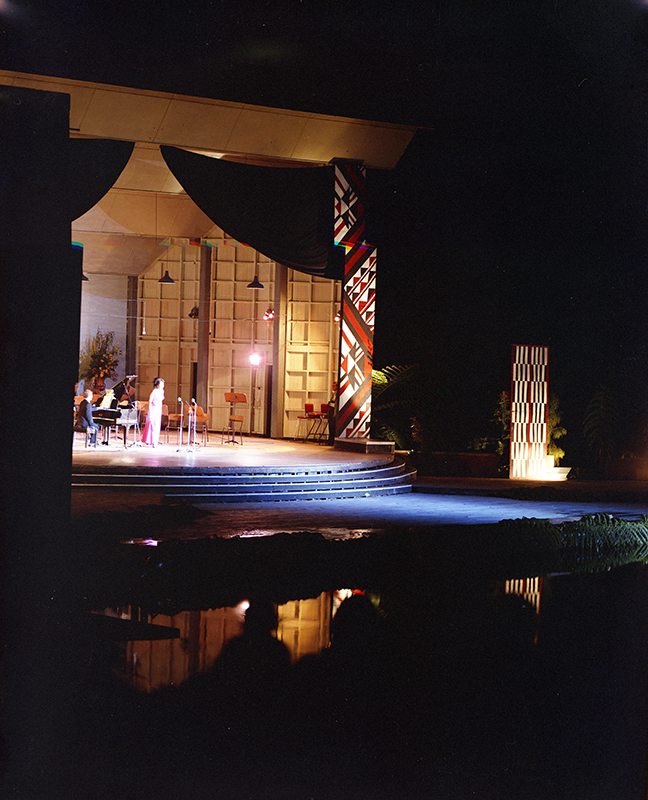
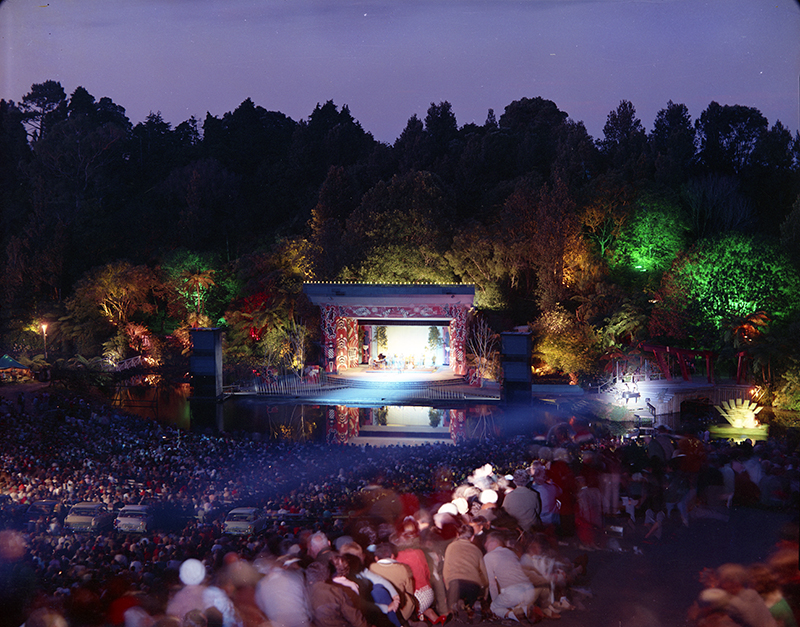
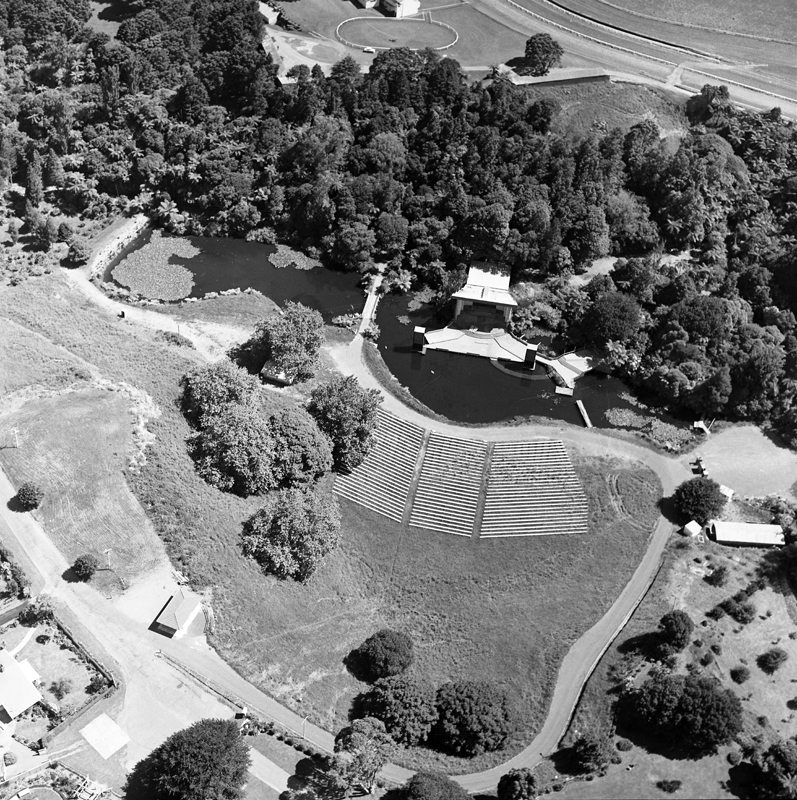
The Bowl is a result of one man's dream, thousands of hours of volunteer labour and good old Kiwi No.8 wire ingenuity. The venue's beginning was back in 1954 when the Pukekura Park Committee considered a proposal for a sound shell in Pukekura Park. That plan was shelved, but two years later New Plymouth public relations officer Eric Handbury revived the idea.
As the city's first public relations officer Eric's job was to attract tourists to the region. The area had a lot to offer including Mount Taranaki, sandy beaches, and many parks, but it lacked event venues. Eric arrived in New Plymouth in 1956 full of great ideas to attract tourists and their money to Taranaki.
The Yorkshire man was a former merchant navy seaman. Sheila Connell was his secretary at the time. "He was a big man, ex-naval type who smoked like a chimney and was always laughing. He had ideas coming out of him, he just couldn't work on them fast enough. And he had this wonderful ability to sell his ideas, his enthusiasm was infectious. People believed in him."
At the far end of Pukekura Park was Brooklands, a 21.5 hectare property that had been gifted to the New Plymouth Borough Council by the estate of Newton King. In Newton King's time the park had included a two-story home, demolished by the council because it didn't know what to do with it, overlooking a large bowl shaped valley containing a lake. It wasn't long before Eric cottoned on to this hidden gem.
"I remember the day in May 1957 when he rushed into the office saying 'Come on, Miss Jones, close the office, we're going to Brooklands Park'," recalls Sheila, whose maiden name was Jones. Eric left the young woman at the highest point of the ‘cow pasture’ while he carried on down to the lowest point by the lake. "He then demonstrated to me what a wonderful natural amphitheatre this area was. I could hear everything he said across this distance and he hardly raised his voice. He rushed up and said to me, 'There you go - this is a natural sound shell. This is going to be the Bowl of Brooklands!'"
Instead of an overgrown swampy valley Eric saw a vast open-air theatre that would hold its stage and its players in the valley, and stretch up to the pines on the skyline. He saw thousands of spectators upon the natural terraces, a stage and entertainment similar to the grand amphitheatre at the Hollywood Bowl in the USA.
In June 1957 Eric pitched this idea to the Pukekura Park Committee who gave the project the thumbs up. The next day the Taranaki Herald enthused about the project: "At last New Plymouth has been offered the promise of a distinctively artistic event without comparison in New Zealand. An open-air theatre with the staging in a lakeland setting, the whole in a natural amphitheatre with adequate car parking, should satisfy the most discriminating."
The Public Relations Office staff barely had enough money to pay their own salaries, let alone finance a huge undertaking such as this. "Eric was paid a pittance of a salary" recalls Sheila. "So was I for that matter. We did it for the love of it. We had to do things to raise money for our salaries - like running a mystery envelope thing." The only answer was getting the community in behind the project, using volunteer labour and asking local businesses to donate their time and materials.
Eric's enthusiasm was contagious and the people of New Plymouth embraced the dream. "It was infectious" says Sheila. "Eric had that wonderful skill of exciting people. I can see him now sitting there ringing all these people in the phone book saying, 'Do you think you could donate us some timber? Could you possibly come down and help us too?' He got the best out of everybody." Eric organised a group of volunteers including surveyors, architects, carpenters, electricians, plumbers, and anyone else willing to wield a shovel or hammer. They gave up their weekends to shift soil, lay concrete and build seating. Plans were to have the Bowl of Brooklands up and running in seven months.
Eric had pictured a week-long arts and music event to be held in February. He called it The Festival of the Pines after the trees that dominated the skyline above the native bush on Brookland's flanks. "They had a singular beauty, outstanding amongst the exotic growth of fern and ponga on the slopes below" he once wrote. As well as organising construction of the Bowl Eric set about putting together a festival that would become the most exciting week New Plymouth had ever seen.
On 17 August 1957 two big earth moving machines began work. They trundled over the hillside, smoothing out the contours to create a sloped seating area, pushing the earth into the swamp around the lake. Volunteers carted wheelbarrow-loads of soil from the small island in the middle of the lake. It was hard backbreaking work that took six men two months to complete.
The project became a real community event. Wives brought sandwiches and flasks of tea for lunch and children played on the mounds of soil. The huge undertaking relied heavily on volunteer labour, but as the rains of spring came and soil turned to mud, enthusiasm for the project waned. Weekly appeals for help appeared in the local papers brought a group of hard-core dedicated volunteers who ventured out in all weathers.
By the end of December construction of the main concrete stage was finished, next on the list was the giant soundshell. The soundshell was a parabolic arch made of timber, suspended from a tubular metal frame. Just four weeks before the start of the festival 25 volunteers hoisted the arch into place using ropes. The full stage was completed just two weeks before the opening of the festival.
Also completed just in time was the enough seating for 4,500 people. This involved volunteers driving 13,000 stakes into the ground then attaching planks for seating. Standing back and looking at it all Eric breathed a sigh of relief. "It is a moment I shall never forget, a moment of exquisite relief and overwhelming triumph!" he later wrote.
"Everything was rather basic" recalls Sheila. "The dressing room for Irish tenor Patrick O'Hagen was a shipping box with a kerosene lamp for lighting, the seats for the audience were made from undressed timber and the toilet block was made out of packing cases. Everything had been done on a shoestring budget - but nobody cared."
The toilets were one of the last things erected - by which time timber supplies had run out. A donation of packing cases provided wood for the walls and a crude structure was put up. There wasn't enough wood for roofing so the men's toilets were open to the stars. Kerosene lamps provided lighting. "We designed the ladies without doors in the mistaken opinion that women had the same companionable instincts as men have at such times" wrote Eric. After many complaints curtains were hung over the entrance to each bay. The finished toilet block was a ‘daymare’ as Eric put it. "It required the cloak of darkness to hide its crudeness of construction and the innumerable 'CC Wards Ltd - handle with care' stamps."
The Bowl was described at the time as "a modernistic sound shell with a cantilever roof, designed to fit in with the scenery. Approximately 8,000 people can be seated on the wooden seats and another 8,000 on the slopes surrounding 'the bowl' A curtain is formed by a floodlit waterfall which rises 15 feet and falls back into the lake, with lights of many colours reflected in it."
But in the lead up to the opening a problem arose. The frogs croaking in the lake were loud enough to drown out the performers. In an effort to get rid of them around 200 kilograms of salt was poured into the lake in the hope that the change in salinity would shift the noisy amphibians. When this didn't work Eric suggested they use gelignite to blast the frogs out of the water. There was a huge outcry from the public. Controversy raged until a university professor pointed out that the frogs only croaked during their two-week mating period. Luckily the festival was a few weeks away, by which time the frogs had finished their courtship and everything was quiet.
Like magic, the storm clouds parted and the sun shone in time for seven days of festivities beginning on 25 February. A line-up that included Irish tenor Patrick O'Hagen, ballet, open-air theatre, a Miss Bowl of Brooklands contest, a massed choir and a concert by the National Orchestra brought a total of 45,000 people to the new amphitheatre. New Plymouth was in party mood. Festival Games were held in Pukekura Park, thousands of people flocked to the air pageant held at the Bell Block aerodrome and a parade of local homes was held.
Eric had persuaded the Army to bring howitzers to the event and the National Orchestra rounded off the festival by playing Tschaikovsky's 1812 overture with guns booming and fireworks giving a glorious display. "What a week!" raved one newspaper. "There was magic abroad in New Plymouth last night. In its web of enchantment it caught about 4000 people who fell happy to the unchallenged beauty of the Bowl of Brooklands" wrote one reporter. On the last night, sitting by the stage, gazing up at "thousands of cigarettes winking on the hill" Eric Handbury breathed a sigh of relief and wept, overcome by the success of the venture.
Over the years productions at the Bowl grew more successful. In 1968 a record 17,500 people packed into the amphitheatre for a concert by the Seekers. The Festival of the Pines, along with a Miss Brooklands pageant, flourished until the 1970s when the twin blows of television and daylight saving knocked it out. By then the Bowl was looking a little shabby. Improvements brought back the big audiences: 15,000 for Split Enz in 1984, 10,000 for UB40 in 1989 and 15,000 for Cliff Richard and Olivia Newton John in 1998. The outdoor amphitheatre has become an icon renowned for its park-like setting.
By this time the Handbury family had long gone. Eric spent six years as New Plymouth's public relations officer before moving to Canada in 1962 looking for better opportunities. But he kept in touch with friends in New Plymouth and followed with a keen eye what was happening at the Bowl of Brooklands. He was immensely proud of the Bowl, but modest about his achievements. "It was the best time I ever had in my life. It was just a wonderful time dealing with wonderful people - extraordinary people with very little money who put together enormous tourist attractions."
There were many people involved in the setup of the Bowl and that first Festival, people who gave their time and effort, who donated materials and worked behind the scenes, along with Eric they made a unique and much-loved venue.
Today's Bowl is a far cry from the early days of 1958 when the first festival was a “dream built of high hopes, No 8 wire and enthusiasm” says Sheila. The lake has been made smaller so the audience can see more, the stage has been modernised and rebuilt and the seating area has been made more comfortable, but the essence is still there: the glittering lake, the trees and the stars, that same feeling of something special. Eric died in 2001, leaving behind a legacy half a world away. In early 2006 a plaque on a rock was unveiled that pays tribute to Eric and his helpers who built a Taranaki icon out of a dream.
Friends of the Bowl of Brooklands (2012). Bowl of Brooklands. New Plymouth: Friends of the Bowl of Brooklands Inc.
Scanlan, A. B. (1950). Pukekura Park and Brooklands, New Plymouth, New Zealand. New Plymouth: Avery Press.
Scanlan, A. B. (1978). Pukekura: a centennial history of Pukekura Park and Brooklands. New Plymouth: New Plymouth City Council.
Quinn, P. (1999). Pukekura Park and Brooklands: a park for all people. Thames: Quintessential Pub.
Please do not reproduce these images without permission from Puke Ariki.
Contact us for more information or you can order images online here.